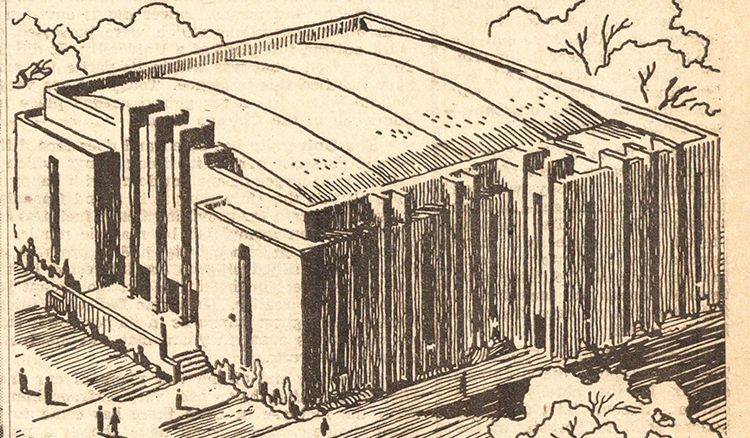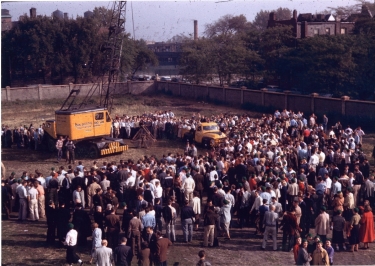 An early draft of the design for Alumni Hall published in the April 4, 1950 issue of "The DePaulia." (DePaul University/Special Collections and Archives)
An early draft of the design for Alumni Hall published in the April 4, 1950 issue of "The DePaulia." (DePaul University/Special Collections and Archives)
As DePaul begins a new era in its athletics program with the opening of Wintrust Arena, it is easy to find oneself looking back over the numerous buildings that have served as a home for athletics throughout DePaul's history. This year, Dec. 16 marks the 61st anniversary of the dedication of Alumni Hall, the building that served as the home for DePaul athletics and events for 44 years. Though Alumni Hall has now been gone for more than 17 years, it still stands out in the memories of many alumni as a beloved part of their DePaul experience.
Fundraising for Alumni Hall began in 1950. The earliest mention in "The DePaulia" is from Jan. 13, 1950, when sports editor Ed Pazdur wrote the alumni association had officially announced a fundraising campaign to invest in a new fieldhouse. In the April 4, 1950 issue, Pazdur reported on a student-led five-week campaign to raise $25,000, which was set to kick off with a raffle on April 11. The two grand prizes in the raffle were a 1950 Buick Super Riviera and a 1950 Ford convertible. The alumni association hosted a fundraising banquet on April 4 at Palmer House. Both students and the alumni association would continue to hold their respective fundraisers annually until Alumni Hall finally became a reality.
Construction began in 1955 with a groundbreaking ceremony on Oct. 3.
"I wish to stress the importance of this occasion as one of the most significant events in the history of DePaul University, an event that spells the confidence we at DePaul have in our educational program and the optimism with which we look to a promising future in the service of young men and women of Chicagoland," said the Very Reverend Comerford J. O'Malley, then president of DePaul.
Fr. O'Malley went on to emphasize how Alumni Hall and everything it would eventually bring to the DePaul community was a direct result of the hard work and genuine enthusiasm of the alumni and student bodies. This theme appears throughout the various writings about the hall that appeared prior to its construction, and gives some insight into one of the many reasons why Alumni Hall was so meaningful to the university community. It was not simply a new and modern fieldhouse or a place dedicated solely to sports and other student events. Alumni Hall was a direct product of the efforts put in by alumni and students over five years - it could not have existed without these efforts.
 An aerial view of the groundbreaking ceremony on Oct. 3, 1955. (DePaul University/Special Collections and Archives)
An aerial view of the groundbreaking ceremony on Oct. 3, 1955. (DePaul University/Special Collections and Archives)
The university dedicated Alumni Hall on Dec. 16, 1956, complete with a blessing by his Eminence Samuel Cardinal Stritch, then Archbishop of Chicago. The building ultimately cost around $2 million - equivalent to almost $18 million today. However, the expense ultimately proved to be worth it. The finished building included classrooms, offices, an arena, a gymnasium with 5,200 seats, a swimming pool, locker rooms, handball courts and a cafeteria. At the dedication, Fr. O'Malley again spoke of Alumni Hall's meaning to the community.
"Through alumni, students, and friends of DePaul...this $2 million structure stands as a monument in granite, stone, and steel to the generosity of many individuals and organizations," he stated.
For 44 years, the hall stood as just that. It served as the home of Blue Demon sports, most notably the men's basketball team under then coach Ray Meyer. But it also served as a center of DePaul student life, hosting concerts and numerous other campus events.
However, Alumni Hall could not stand forever. After a certain point, Alumni Hall was no longer able to serve the needs of a growing and changing DePaul student population. Following years of planning for a new student center, the building was officially closed on Feb. 26, 2000. Later that year in April, DePaul held the Alumni Hall Wrecking Ball, an auction of memorabilia from the hall to raise money for athletics. Two months later, demolition of Alumni Hall began.
Though the university gained two great additions in the wake of Alumni Hall's removal - the Ray Meyer Fitness and Recreation Center, and the Student Center - the building lives on in the consciousness and hearts of the DePaul community. Alumni Hall was built for students and alumni, by students and alumni, and this fact made all the memories created there over the building's 44-year life all the more meaningful.